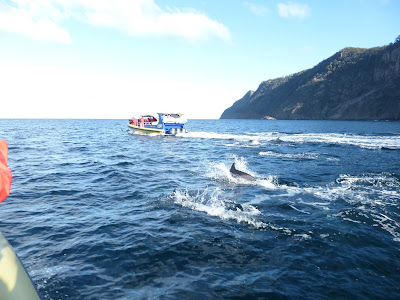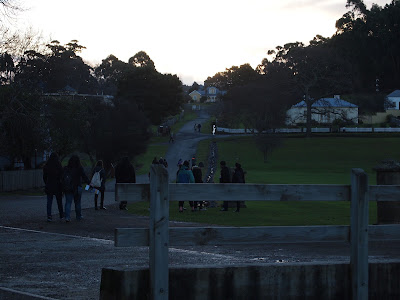The boat tour was fun, and the weather stayed nice and sunny so it was only regular freezing cold rather than rainy freezing cold! They cruised us past the cliffs to see a bunch of cool rock formations and also drove through one of them for a bit of a thrill.
 |
| eagle rock |
 |
| Madonna and king on camel |
 |
| the cathedral |
We spent some time at an underwater blow-hole which makes a cool sucking noise before it spouts water every few seconds.
We saw lots of birds including cormorants and oyster catchers (ones with a long orange beak) and then cruised around a huge colony of fur seals with churning water all around and a few of them basking in the waves.
On the way back, we were in the open ocean and just at the end managed to catch a pod of common dolphins feeding. They were such delightful creatures to watch, with some jumping in the air and riding the bow of the other cruise ship. I'm really glad we got to see the dolphins - definitely the highlight of the trip.
On the drive back to the ferry, we climbed the steps on the neck of Bruny Island to see over the island halves.
At the bottom of the stairs at the neck there was a sign about Truganini, an Aboriginal woman, to whom the Tasmanian Aboriginal community had dedicated the site. I had been thinking about how easy it is to visit Australia and New Zealand without really any interaction, presence, or information about the indigenous peoples, so I thought it important to read about her story (especially since she is a woman) and do my bit to share it and make women more visible. She had some awful things done to her by white men yet she still survived. The glare was quite harsh, so I'll re-type the main part:
This part of Lunawanna-alonnah (Bruny Island) is rich with evidence of Aboriginal occupation. For this reason, the Tasmanian Aboriginal community has dedicated the site to the memory of Truganini - a Nuenone woman whose life was forever changed by white invasion. As a child, Truganini grew up here at Lunawanna-alonnah. Her father was an elder of the Nuenone people, a band of the south-east tribe whose connection with this place spans 30,000 years.
Tragedy
The peace of Truganini's early years was shattered by European invasion. The arrival of white man brought violence and brutality to these shores. At the age of 17, Truganini witnessed the horrific stabbing murder of her mother by men from a whaling ship. Sealers kidnapped here two sisters, Lowhe-nunne and Magger-leede. Timber-getters killed the man Truganimi was to marry. During a boat crossing of the Channel, she watched in horror as her husband-to-be was thrown into the sea. As he tried desperately to climb back onboard, the timber-getters cut off his hands and left him to drown. Truganini was then repeatedly raped. Her brother was killed and her stepmother kidnapped by escaped convicts. Her father was devastated and died within months.
Deception
Following the loss of her entire family, Truganini worked as a guide and interpreter for George Robinson, who had been appointed by the colonial government to persuade Aborigines to peacefully give up their land. A promise that all would be returned to their homelands after a period of exile was ultimately broken. Truganini spent many years at the Wybalenna Aboriginal Settlement on Flinders Island, where efforts were made to strip Aboriginal people of their identity and culture. Many died of disease or despair Truganini's cooperation later turned to rebellion. For a time, she escaped and was involved in attacks on white men. ....
That was the end of our day trip to Bruny Island. We took the car back over the ferry and then savored our last day by eating out at Hog's Breath Cafe, which is a chain of restaurants in Australia. They marinade their steaks for something like 18 hours, so they are incredibly tender and delicious. It was one of the best I've ever had. And so ended our really nice trip to Melbourne and Tasmania!

















































